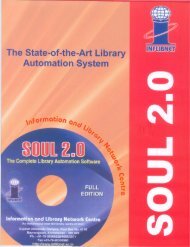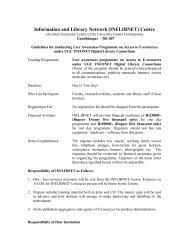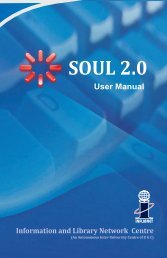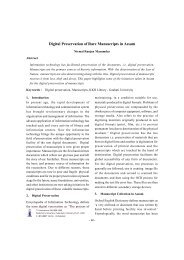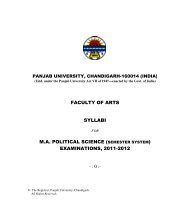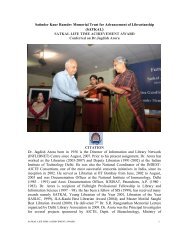Digitization as a Means of Preservation of Manuscripts - INFLIBNET ...
Digitization as a Means of Preservation of Manuscripts - INFLIBNET ...
Digitization as a Means of Preservation of Manuscripts - INFLIBNET ...
Create successful ePaper yourself
Turn your PDF publications into a flip-book with our unique Google optimized e-Paper software.
<strong>Digitization</strong> <strong>as</strong> a <strong>Means</strong> <strong>of</strong> <strong>Preservation</strong> <strong>of</strong> <strong>Manuscripts</strong>---- 7 th International CALIBER 2009<strong>Digitization</strong> <strong>as</strong> a <strong>Means</strong> <strong>of</strong> <strong>Preservation</strong> <strong>of</strong> <strong>Manuscripts</strong>: C<strong>as</strong>e study <strong>of</strong> OsmaniaUniversity LibraryAbstractFazluddin AhmedThis paper presents digitization <strong>as</strong> a means <strong>of</strong> preservation <strong>of</strong> manuscripts. It discusses the hardware and s<strong>of</strong>t ware available for digitization. A complete overview <strong>of</strong> digitization process h<strong>as</strong> alsobeen explained.Keywords:<strong>Digitization</strong>, Digital Camera, OCR, Metadata, PDF1. IntroductionTraditional libraries were only store house <strong>of</strong> books.The books were kept in locked cupboards and accessto them w<strong>as</strong> limited. The traditional libraries werestatic in the <strong>as</strong>pect <strong>of</strong> development. Open accesssystem and preparation <strong>of</strong> catalogue cardsrevolutionized the library and its services.Computers were used in the early sixties by thelibraries for their various operations. Librariescurrently have experienced technological changein information storage and its retrieval. Themedium <strong>of</strong> information storage h<strong>as</strong> changed fromclay tablets, palm leaves to paper and now toelectronic and optical media.The traditional preservation method constitute <strong>of</strong>all form <strong>of</strong> direct actions aimed at the lifeexpectancy <strong>of</strong> undamaged or damaged elements <strong>of</strong>manuscript like mechanical cleaning solventcleaning etc .Machine made paper made <strong>of</strong> woodpulp containing harmful acidic ingredients thatcaused deterioration w<strong>as</strong> used.<strong>Preservation</strong> ensures that people present and futurewill have access to the information that constitutesthe documentary heritage.7 th International CALIBER-2009,Pondicherry University, Puducherry, February 25-27, 2009© <strong>INFLIBNET</strong> Centre, Ahmedabad- 93 -In terms <strong>of</strong> preservation, digital conversion cancertainly extend the life <strong>of</strong> a particular artifact. Theuse <strong>of</strong> original can be restricted and a high qualitysurrogate can be provided. <strong>Digitization</strong> enhancesaccess to the artifact. <strong>as</strong> its image can be seen onthe web by users all over the world. In addition tothis it can be sent for <strong>of</strong>fline viewing using a higherresolution uncompressed m<strong>as</strong>ter file.2. Factors Responsible for <strong>Digitization</strong>:According to Becker, seven technological advanceshave created the environment for digitization.a. PCs are much more cost effective and powerfulin comparison to a few years ago.b. Scanning technologies have become cheaperand better, allowing computers to convertmanuscripts, pictures and color photos intodigital files.c. Storage technologies have improved in terms<strong>of</strong> price and physical space required.d. The rapid growth <strong>of</strong> internet, which providesever widening access to the digitizedinformation.e. The emergence <strong>of</strong> more widely acceptedstandard protocols.f. The incre<strong>as</strong>ed use <strong>of</strong> standards like SGML andHTML.
7 th International CALIBER 2009 <strong>Digitization</strong> <strong>as</strong> a <strong>Means</strong> <strong>of</strong> <strong>Preservation</strong> <strong>of</strong> <strong>Manuscripts</strong>----g. The emergence <strong>of</strong> standard image formats andcompression technologies making it possibleto share images on computers.Presently, libraries are linked through networks <strong>of</strong>various types. The changes brought by advancementin technology have been so extensive that it isdifficult to <strong>as</strong>sess their total effect but it is clearthat libraries are in state <strong>of</strong> fundamentaltransformation from manual to electronic, digitaland virtual library.3. Tools for <strong>Digitization</strong>The Hardware and S<strong>of</strong>tware tools for digitizationare <strong>as</strong> follows.3.1 Hardwarea. A Computer with the following MinimumConfigurationPentium 4 cl<strong>as</strong>s processor running at 2.0 GHz orhigher512MBminimum memory160GBHard drive18"or larger monitor128MBvideo cardCD-RWand/or DVD-R optical driveb. ScannersScanners are <strong>of</strong> various types. Flat bed scanner isthe most commonly used.c. Digital cameraA digital camera uses a light sensitive processorchip to capture photographic images in digital formon a small diskette inserted in the camera or onfl<strong>as</strong>h memory chips. Digital camer<strong>as</strong> snap picturesby providing a real digital bit map to read directlyinto application.3.2 S<strong>of</strong>t wareThe s<strong>of</strong>t ware required is <strong>as</strong> followsHTML editorXML editorOCR s<strong>of</strong>twareImage editorPage layout and design s<strong>of</strong>twarePDF s<strong>of</strong>twareOCR:The most important s<strong>of</strong>tware is optical characterrecognition. OCR or text recognition is the process<strong>of</strong> electronically identifying text in a bit mappedpage image or set <strong>of</strong> images and then creating afile containing that text in ASCII code or inspecified word processing format. OCR isperformed in order to make every word in thescanned documents computer readable and fullysearchable without having to key every thing intothe computer manually. OCR technologysuccessfully permits the reading <strong>of</strong> documentscontaining a mixture <strong>of</strong> fonts in different sizes andstylesImage editorThis program allows saving images in multiple fileformats, resizing images, cropping etc. The bestexample <strong>of</strong> this s<strong>of</strong>tware is adobe Photoshop.PAGE layout and design s<strong>of</strong>tware. This s<strong>of</strong>twareh<strong>as</strong> more design features than word processors.Adobe page maker is one <strong>of</strong> the s<strong>of</strong>tware availablefor this purpose.PDF s<strong>of</strong>twarePDF is a widely used format .It provides a quickand e<strong>as</strong>y solution for viewing and downloading theonline files. This s<strong>of</strong>tware is freely available oninternet. This formats popularity can be gaugedfrom the files available on internet.- 94 -
<strong>Digitization</strong> <strong>as</strong> a <strong>Means</strong> <strong>of</strong> <strong>Preservation</strong> <strong>of</strong> <strong>Manuscripts</strong>---- 7 th International CALIBER 20094. Osmania University4.1 History and back groundOsmania University w<strong>as</strong> established in 1918 andthe university library w<strong>as</strong> an integral part <strong>of</strong> it. In1919 the library w<strong>as</strong> divided into two sections theoccidental and oriental sections with a modestcollection <strong>of</strong> 2124 and 3313 volumes respectively.The library is working in the present building since3 rd August 1963.Sar<strong>as</strong>wathi and the 10 Avatars <strong>of</strong> Vishnu. Originalcolors are used in this painting.b. Mahabharata manuscripts :There are two manuscripts <strong>of</strong> the Mahabharata <strong>of</strong>two different sizes. Each page contains miniaturepaintings <strong>of</strong> the characters mentioned in the texton that particular page4.2 Library systemThe present Osmania university library system iscomplex in nature. It consists <strong>of</strong> University library,seminar libraries and constituent college libraries.Seminar libraries located in the respectivedepartment <strong>of</strong> various faculties in the universitycampus and constituent college libraries attachedto the colleges.4.3 <strong>Manuscripts</strong> available at universitylibraryUniversity library h<strong>as</strong> a rich collection <strong>of</strong>manuscripts. The total number <strong>of</strong> manuscripts is6825. There are two types <strong>of</strong> manuscripts availablein the library one being paper and the other palmleaf. The manuscripts available are in Sanskrit,Kannada, Tamil, Marathi, Hindi, Arabic, PersianUrdu and Turkish language .The condition <strong>of</strong> papermanuscripts is better than that <strong>of</strong> the palm leaf.The manuscripts are preserved in specially madecupboards. There are two fumigation chambersavailable for preservation <strong>of</strong> manuscripts.. Somemanuscripts which are rare and having artistic valueare;a. Bhagvata ScrollThis is a 64ft long scroll having width <strong>of</strong> 4 inches.It h<strong>as</strong> complete text <strong>of</strong> the 12 Skandh<strong>as</strong> <strong>of</strong> SrimadBhagvata.it contains miniature paintings <strong>of</strong> Ganesa- 95 -
7 th International CALIBER 2009 <strong>Digitization</strong> <strong>as</strong> a <strong>Means</strong> <strong>of</strong> <strong>Preservation</strong> <strong>of</strong> <strong>Manuscripts</strong>----Osmania University signed a memorandum <strong>of</strong>standing (MOU) with Juma-al-majid centre forculture and heritage, Dubai for digitization <strong>of</strong>manuscripts available at university library. It w<strong>as</strong>decided that the total collection <strong>of</strong> the manuscripts(paper and palm leaf) be digitized.manuscripts which do not even have accessionnumber. They were also digitized and keptseparately.4.6 Scanning4.4 Selection ProcessIt w<strong>as</strong> decided to get the total manuscripts digitized.Firstly the work <strong>of</strong> paper manuscript w<strong>as</strong> started.The manuscripts which were in deteriorativecondition were given treatment. The palm leavesmanuscripts were mechanically cleaned andcitronella oil w<strong>as</strong> applied to the leaves. This helpedfor getting clear image <strong>of</strong> the leaf.4.5 Preparation <strong>of</strong> Meta DataA register w<strong>as</strong> maintained for the manuscripts sentfor digitization details <strong>of</strong> the manuscript such <strong>as</strong>author, title, folios, scribe date etc were noted inthis registerA separate register h<strong>as</strong> been maintained for eachlanguage after which the manuscripts were sent fordigitization. The digitization centre also maintainsMeta data which w<strong>as</strong> filled up in the Performa. Thedigitization process starts with the first image <strong>as</strong>Meta data <strong>of</strong> the manuscripts.Preparation <strong>of</strong> Meta data for various languages likeSanskrit, Kannada, Arabic, Marathi, and Turkishrequired the help <strong>of</strong> respective language experts.The multilingual nature <strong>of</strong> university library h<strong>as</strong>helped in deciphering <strong>of</strong> title, author and otherinformation. All the information h<strong>as</strong> been writtenin Roman English. The palm leaf manuscripts haveaccession number mentioned on them. Theauthorship and title can’t be read at the time <strong>of</strong>digitization. There were some complete palm leafThe scanning work w<strong>as</strong> done with the use <strong>of</strong> Sonycyber shot DSC_H5. Digital camera. This camera<strong>of</strong>fers a sensor resolution <strong>of</strong> seven mega pixels alongwith the a new Carl zeiss vario- tessar 12xopticalzoom lens with 58mm threading and super steadyshot optical image stabilization.The H5 can shot <strong>as</strong> high <strong>as</strong> ISO 1000. Thespecifications <strong>of</strong> camera are <strong>as</strong> follows:Sensor1 / 2.5 “ Type LCD7.2 millionEffective pixels.Image sizes 3072 x 23043072 x 2048 (3:2)2592x 19442048 x 15361632 x 1224640x 480File format JPEGLens36-432 mm equiv12 x opticalzoomCarl zeiss vario-tessar F2. 8-3.7Digital zoom 2 x (24 x total)up to 57 x smart zoom(dependent on selected resolution)LCD Monitor 3.0 inch TFT230 k pixelsConnectivity USB 2.0 high speed AV outStorage Memory stick duo/ pro duocompatible32 MB internal memoryPower2xNIMH batteries AC adapter(optimal)- 96 -
<strong>Digitization</strong> <strong>as</strong> a <strong>Means</strong> <strong>of</strong> <strong>Preservation</strong> <strong>of</strong> <strong>Manuscripts</strong>---- 7 th International CALIBER 2009The camera w<strong>as</strong> fixed on the Hama pr<strong>of</strong>essionalcamera stand. The stand h<strong>as</strong> 4 bulbs <strong>of</strong> 150 wattseach to focus on the image to be digitized. A mirrorw<strong>as</strong> fixed to check the clarity <strong>of</strong> the image availablein the camera. Fixing the mirror helped to workeven by sitting on the chair. The manuscripts werekept on the stand and the size <strong>of</strong> the image w<strong>as</strong>fixed in the camera. After checking the image inthe mirror, it w<strong>as</strong> captured the number <strong>of</strong> imagescaptured is limited by the size <strong>of</strong> the memory <strong>of</strong>camera. The memory card that had been used is <strong>of</strong>1 GB. When the memory is full the images weretransferred to the computer using the USB datacable. The images <strong>of</strong> the manuscripts were storedin the computer. Three persons were engaged fordigitization work and a person w<strong>as</strong> dedicated forstoring the images in the computer and for carryingout the OCR. The images were verified and each <strong>of</strong>them w<strong>as</strong> stored.4.7 Renaming FilesThe stored digital images in the computer for eachmanuscript were renamed. Renaming is done byusing the accession number <strong>of</strong> the manuscript. Dueto non-availability <strong>of</strong> author and title name,accession number w<strong>as</strong> used for identifying amanuscript.4.8 Merging filesWhen the files were ready after renaming, a newfolder w<strong>as</strong> created and the files were merged in thisfolder up to 700MB containing manuscripts varyingfrom 5to 6 in numbers.4.9 StorageWhen the folders containing manuscripts wereready, storage process is started. These manuscriptswere written on CD .A detailed list <strong>of</strong> contents <strong>of</strong>CDs w<strong>as</strong> prepared which act <strong>as</strong> an index to the cds.4.10 AvailabilityThe CDs along with the list is been handed over tothe library by the digitization centre. The cds arechecked with the list provided. The manuscriptswill soon be available on web opac. The work h<strong>as</strong>been started. University library is using New GenLib s<strong>of</strong>tware for its library operations and web opac.The data entry for Sanskrit manuscripts (paper) h<strong>as</strong>been started the availability can be checked bylogging into library’s opac.5. FutureA new terabyte server h<strong>as</strong> been purch<strong>as</strong>ed. The jumaalmajid centre h<strong>as</strong> also provided two hard discs inwhich the total digitized manuscripts are madeavailable. With the use <strong>of</strong> terra byte server themanuscripts will be available to users via intranet.References1. Anderson, cokie g. starting a digitizationcentre. Oxford: chandos publishing, 20042 Arms, William y .Digital libraries.London:MITpress, 20003. www.sony-<strong>as</strong>ia.com/cybershot.4. Becker, j The Guts <strong>of</strong> the Digital libraryinformation technology services maintainingsystem LC. information:262About AuthorMr. Fazluddin Ahmed, Library Assistant,University Library, Osmania University, AndhraPradeshE-mail: fazaluddinahmed@yahoo.com- 97 -



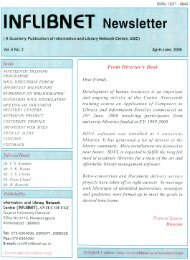


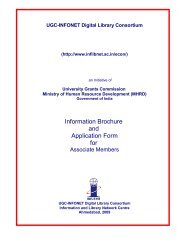
![Uni of Delhi_MA_History[1]. - INFLIBNET Centre](https://img.yumpu.com/48586372/1/190x245/uni-of-delhi-ma-history1-inflibnet-centre.jpg?quality=85)
